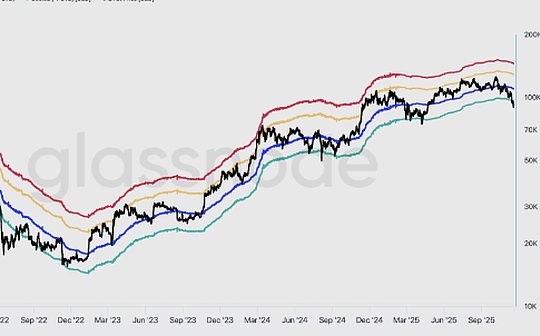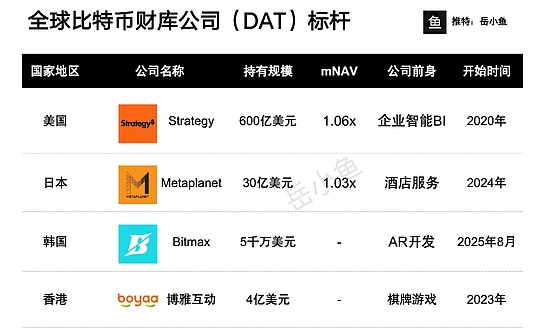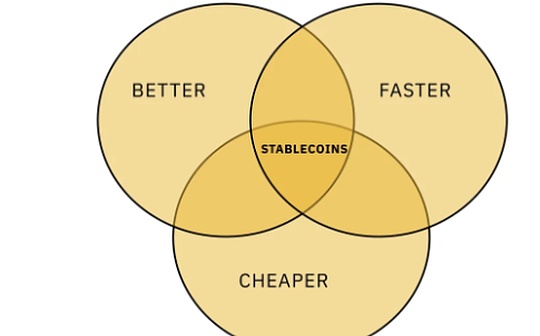
Author: Ryan Barney and Mason Nystrom, Partner at Pantera Capital; Compiled by: 0xjs@Bitchain Vision
Stablecoins are a trillion-dollar opportunity.
This is not an exaggeration.
Although cryptocurrencies are generally considered to be volatile, tokens and liquid, the other side of cryptocurrencies is the stablecoin that is more silently holding the banner of cryptocurrencies.For beginners, these crypto dollars are pegged to the underlying fiat currency 1:1, using algorithms (less popular) or reserves (more popular) to maintain the peg.
The proportion of stablecoins in blockchain transactions has increased from 3% in 2020 to more than 50% now.Stablecoins are the proposition of cryptocurrency killer applications, and unlike many cryptocurrencies, stablecoins are inherently non-speculative.

In a short period of time, stablecoins have demonstrated their ability to become one of the transformative innovations in the cryptocurrency field.2024 is the breakout moment for stablecoins, with adjusted trading volume exceeding about $5 trillion and trading volume exceeding $1 billion, involving nearly 200 million accounts.
Stablecoins have achieved remarkable growth in the last cryptocurrency bull market, but this time, the scope of application of stablecoins has exceeded the DeFi ecosystem.In the past few years, stablecoins have demonstrated their core value proposition—seamless cross-border payments—which were initially achieved by acquiring US dollars.Accordingly, the fastest growing regions of stablecoins are emerging markets, which have high demand for the US dollar.

Stablecoins provide a 10x value proposition for traditional payment methods for B2C payments (such as remittances) as well as B2B cross-border transactions.
Cryptocurrencies have long been expected to provide solutions to the trillion-dollar cross-border payment market.By 2024, cross-border B2B payments through traditional payment channels will reach about $40 trillion (excluding wholesale B2B payments) (Juniper Research).In the consumer payment market, global remittances earn hundreds of billions of dollars a year.Now, stablecoins provide the means to realize global cross-border remittance payments through crypto channels.
As the adoption of stablecoins in the B2C and B2B payments sectors is getting faster and faster, the supply and transaction volume of on-chain stablecoins have reached all-time highs.

Stablecoin Trio: Better.Faster.Cheaper.
There is an old saying in the business world: few products can provide something better, faster and cheaper at the same time.Usually, a product can meet two of these conditions at the same time, but it is impossible to meet three conditions at the same time.Stablecoins provide a better, faster and cheaper way to transfer funds globally.
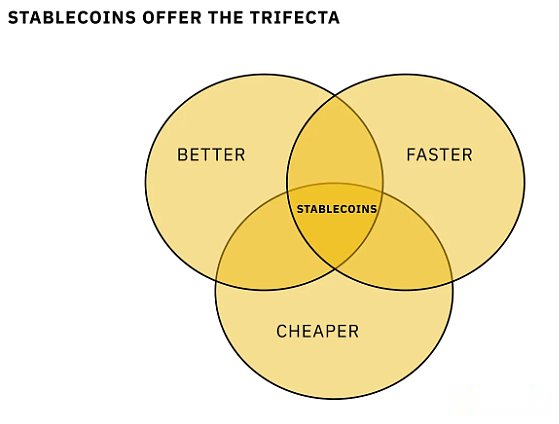 For businesses and consumers, stablecoins offer a value proposition of 10 times higher than traditional dollars.
For businesses and consumers, stablecoins offer a value proposition of 10 times higher than traditional dollars.
better:Stablecoins are a more accessible product that can be used 365 days a year, 24 hours a day.They can easily transmit across the world across the border and are programmable, making stablecoins superior to fiat currencies.

Faster:Stablecoins are undoubtedly faster and can be settled immediately, rather than requiring T-minus 2 or T-minus 1 day to settle.
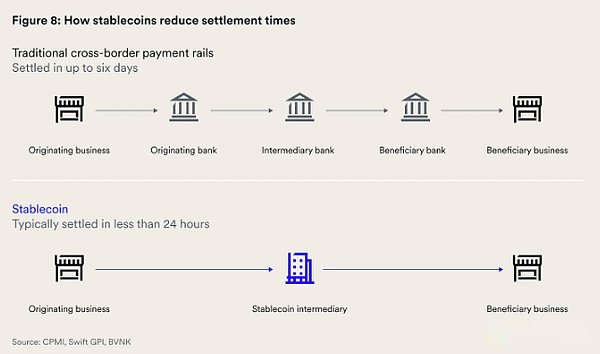
Image from BVNK Report
Cheaper: Stablecoins are issued, transferred and maintained at lower costs than fiat currencies.In 2023, Stripe contributed to more than $1 trillion in payments, with a fee structure starting at 2.9%, with an additional 30 cents for domestic card transactions.On high-throughput blockchains like Solana or Ethereum L2 like Base, the average stablecoin payment cost is less than a cent.
The emerging stablecoin stack
Despite the continuous evolution of the stablecoin stack, some new layers have emerged:
-
Merchant layer——Applications and interfaces for initiating retail or commercial transactions
-
Stablecoin integration(Stablecoin Orchestration) – Provider that provides last-mile entry and exit channels, virtual accounts, cross-border stablecoin transfers or stablecoin and fiat currency exchange
-
Forex and liquidity——Provider that provides exchanges for cross-border stablecoins and other stablecoins pegged to the US dollar, fiat currencies or regional stablecoins.
-
Stablecoin Issuance——Company or agreement that provides white label stablecoins or first-party stablecoins with differentiated characteristics

Similar to the way cryptocurrency exchanges emerge in every corner of the world to cater to local participants, we expect a variety of cryptocurrency cross-border applications and processors to emerge as they cater to specific stablecoin markets.
Just like traditional finance and payments, building a moat in every part of the stack is important to expand business opportunities beyond the initial value proposition.We have considered which moats are defensible and can be expanded at each level over time:
-
Merchant layer——The moat is built by having stablecoin streams with users or businesses.This provides opportunities to upsell other services, sell user flows and have an end-to-end customer experience.The stablecoin’s Robinhood will appear following a similar strategy.
-
Stablecoin integration–license!Whoever gets the license will get the most reliable and global coverage at the cheapest price.Will it be developer-friendly?Check out the acquisition of Stripe x Bridge to see where and how the moat is formed here.
-
Forex and liquidity——Liquidity produces liquidity, and flow produces value accumulation.Any participant who can acquire proprietary liquidity and price effectively will outperform new entrants without it.That’s why some large exchanges today serve most of the stablecoin traffic on some major channels.We also believe that the transition from OTC Forex to Exchange to on-chain Forex will facilitate this layer of faster payments and transactions.
-
Stablecoin Issuance——Over time, issuance will be commoditized and will inevitably lead to the launch of dozens of large-branded stablecoins (such as PYUSD).As other levels of the stack grow (i.e. merchants, business processes, and liquidity), we expect these levels to have the ability to launch their own stablecoins, whether it is to acquire revenue, build their own branded stablecoins, or build proprietary stablecoins.Liquidity and flow.
As the layers of the stack gradually become bundled together, these layers merge over time.The merchant layer is best suited for other layers of the aggregation stack, thus providing more value to the end user, increasing profits and creating more revenue streams.They will have the right to choose which forex transactions they conduct, which entry and exit channels own or lease, and which issuers they use.
Furthermore, we expect stablecoin issuance will become increasingly common for large fintech companies and e-commerce providers that promote large flows of capital.The next generation of new banks and fintech companies will be defined by stablecoins.Just this month, we heard that large credit card networks such as Visa, banks such as JPM, and asset management companies such as Blackrock were interested in exploring their own stablecoin projects.
Looking to the future: The next decade of digital dollars
The tokenization of the US dollar is still in its infancy.
Even if the MAU of stablecoins reaches an all-time high, we believe that adoption will continue as hundreds of millions of people interact with stablecoins over the next decade.
Importantly, stablecoin users are still increasing even in the case of fluctuations in exchange trading volume.From bull to bear markets, stablecoins dominate and expand their digital influence.
As cryptocurrencies rebuild the financial system from scratch, stablecoins also exist and are integrated into the traditional financial payment network.
While large companies like Stripe, Visa and Paypal have all entered the stablecoin market, we see new protocols and companies focusing on stablecoins have a lot of opportunities.
Here are some ideas that excite us:
-
Stablecoin New Bank (Neobank)—The advent of mobile devices has given Neobanks great value.Crypto Neobanks will not only provide first-class payment channels, but will also support the next generation of consumer finance applications that will aggregate payments, transactions, earnings, loans and other core financial services.
-
On-chain forex——Although most stablecoins are currently pegged to the US dollar, we expect more currencies to be on the chain, thereby promoting the development of the on-chain foreign exchange layer.More directly, as a large number of dollar-pegged earnings stablecoins offer different returns and value propositions, we expect these initial dollar-pegged stablecoins to require a Forex layer.
-
Telegram Payment Track——Telegram offers native payment wallets, but we also see a unique opportunity to build a new payment layer on top of Telegram using new interfaces such as TG applets.
-
Remittance on encrypted tracks—Remitly, Wise, Intermex, Ria, MoneyGram, Western Union.All remittance companies, each with annual revenue of hundreds of millions to billions of dollars.Remittance companies charge a fixed fee, which makes sense for low amounts (e.g. $6 for $6 for $60 transactions) or high fees (30-100bps per transaction).Stablecoins reduce the cost of remittances worldwide and make the process seamless.money.“Remittance profit is an opportunity for stablecoins.” – Jeff “Stables” Besos
-
Global Venmo—Build a P2P track to bring Venmo-like functionality to a global scale.Remittances are usually one-way flows, and this will serve social commerce use cases in a more two-way flow.
-
Stablecoin supports fund management and operation——As the fintech field expands from PayPal payments, it has created billions of dollars in wealth management, personal finance, payroll, corporate spending and expense management, new banking, financial accounting and reporting, loan/mortgage loans and moreChance.Likewise, stablecoins provide an opportunity to rebuild many of these tedious processes with better tracks supported by stablecoins.In the short term, fund management and operations deal with complex operations, which allows the value proposition of stablecoins to be subverted.
Conclusion
Stablecoins represent trillions of dollars in business opportunities.We want to support founders and visionaries who can see the future prospects of stablecoins and are not affected by the financial system.


